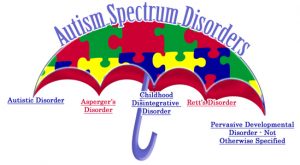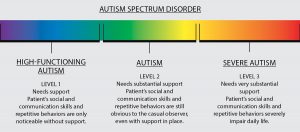
The number of Autism Spectrum Disorder or ASD cases is on the rise. Today the percentage of children with ASD is roughly 2.4% whereas in 2010 the percent was 1.47%. With such a rampant rise in cases it is important to break down the diseases associated with ASD, and the three levels of the Autism spectrum to help better understand what is encompassed by the “umbrella” of ASD.
Let’s talk about the disorders on the spectrum. Many people have heard of Autistic Disorder and Asperger’s, but fewer have heard of Rett’s Syndrome, Childhood Disintegrative Disorder, and PDD-NOS (Pervasive Development Disorder-Not Otherwise Specified).
Autistic Disorder often appears by the age of three through apparent developmental delays. Children with this disorder tend to have trouble with nonverbal behaviors, relationships, sharing enjoyment with others, and empathy. Autistic children tend to have problems with language usage, especially with sustaining conversations, imitative play, and repetitive use of language. Some of the common behaviors associated with Autism are preoccupation, rituals, and repetitive motor mannerisms.
Rett’s is appears anywhere from 5 to 48 months and is often characterized as a deceleration. Children with Rett’s experience loss of social skills, impaired expressive and receptive language, and loss of acquired movements. Rett’s only affects girls as it is found the X chromosome. If a baby boy is born with Rett’s he normally dies before or shortly after birth. This is because boys only have one X chromosome and if there is a defect on that one chromosome it can overtake the body. Since girls have two, the healthy X chromosome helps protect the body against Rett’s Syndrome.
Unlike the previously discussed disorders, Asperger’s does not have a significant delay in childhood development. Many of their niches with social interactions are the same as a child with Autistic Disorder. Like childhood development, Asperger’s does not have significant delays in language. Children with Asperger’s experience behavioral problems much like a child with Autistic Disorder.
Kids with Childhood Disintegrative Disorder start off their lives with normal development up until the age of 2. Then these children lose these acquired skills by the age of 10. Picking this apart even more these children experience the same loss of social skills experienced by children with Autism and lose their expressive language skills. Along with these symptoms these children lose control of their bladders, and motor skills.
PDD-NOS is solely used for children who have an apparent impairment, but they do not meet the criteria for a specific disorder.
Now that we’ve broken down the characteristics of the five disorders on the Autism Spectrum let’s talk about the three levels of the spectrum.

The first level is known as High Functioning Autism. A person who is in this level needs support, but their symptoms are only noticeable if they do not have support.
The second level is called Autism. These people need more support and their behaviors are still observable even with support.
The final level is Severe Autism. A person with level three Autism needs substantial support, and their behavioral problems, and social skills cause problems and or impair everyday life.
Having five disorders under the ASD umbrella and three levels to the spectrum may make a diagnosis seem “nice and neat”. However, not everyone with ASD will fall into a “perfect” diagnosis. It is important to remember that ASD is a SPECTRUM and each case is UNIQUE!
Image 1: http://www.myaspergerschild.com/2011/08/autism-spectrum-disorders-everything.html
Image 2: http://discovermagazine.com/2017/jul-aug/autism-spectrum-disorder